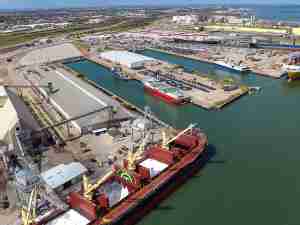Winter storm takes toll on Port Houston volumes
Container activity at Port Houston took a hit in February as a deadly ice storm shut port facilities for nearly a week, bringing cargo movements to a virtual standstill.
The month’s winter storm and the impact of sub-freezing temperatures on both commerce and activity at Port Houston resulted in a tough month as vessel calls and terminal activities were suspended. Port Houston handled 198,763 twenty-foot equivalent units (TEUs) in February of 2021, compared to February of last year when 255,474 TEUs were handled. That brought container activity for the year to 453,802 TEUs, down 13% compared to the record 524,247 TEUs for the same period in 2020.
The decision by Port Houston leadership to halt operations due to the treacherous storm was made to err on the side of safety to ensure the well-being of employees, longshore workers, truckers and others.
“It was a people issue first and foremost,” Executive Director Roger Guenther said of the decision. “Ensuring the safety of our team and partners was our top priority. Icy conditions made it dangerous to operate. There were some issues with power generation in parts of our system, but we were able to get back to 100%. As soon as we were able to safely be up and running, we again began moving cargo with the world-class service our customers have come to expect from us. As our employees and members of labor have proven so many times in the past, we are resilient and we’re confident that our regional growth and strong manufacturing sector will continue driving strong demand in the months ahead.”
Although steel volumes were down due to the continued downturn in the oil and gas sector, those volumes are expected to begin to increase.
“We are hopeful that tonnage will begin looking better in the months ahead, with energy prices on the rise that may spur an increase in drilling activity and demand for pipe,” Guenther noted.
Wind turbine activity, meanwhile, was up considerably again in February 2021 as new renewable energy-related cargo growth unfolded. Texas easily leads the nation in the production of wind energy.
Along with handling a host of breakbulk cargo like pipe and wind equipment, Port Houston also is the sixth largest container port in the United States and is among the fastest growing. Port Houston is the dominant container port on the U.S. Gulf Coast.










